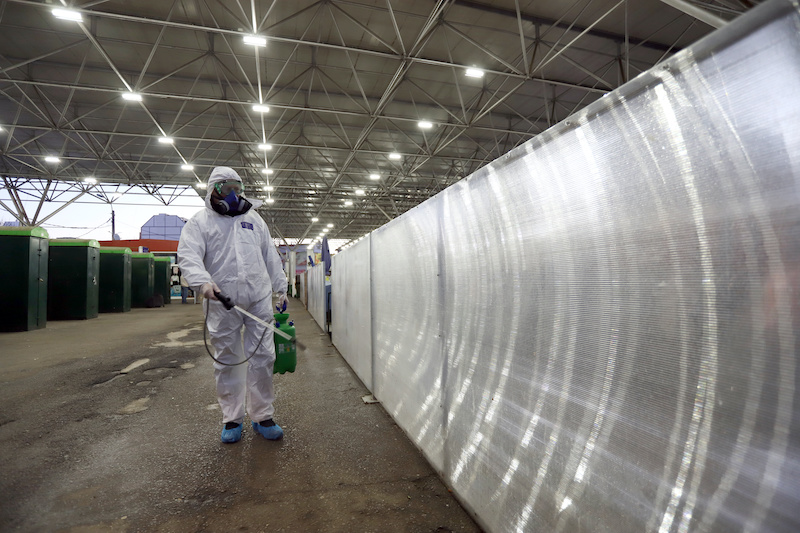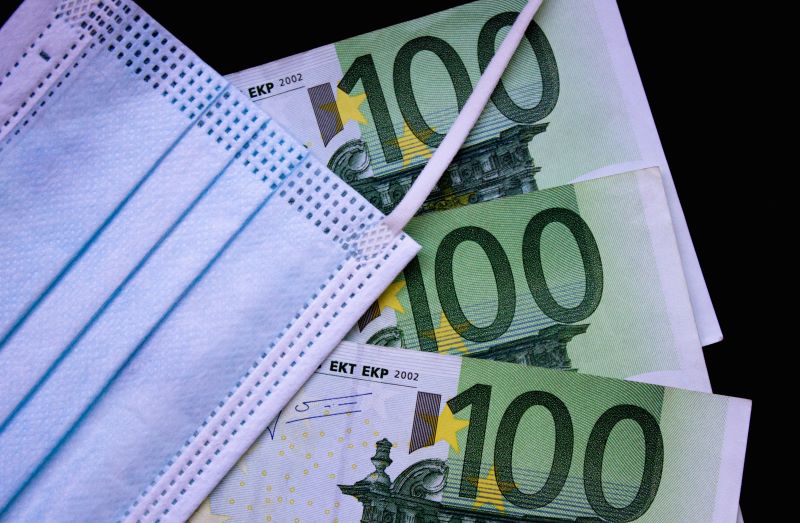Recommended
The American Rescue Plan—the massive COVID-19 relief package recently signed into law—has featured in plenty of headlines. While the vast majority of the nearly $1.9 trillion package is allocated to domestic relief and response, the legislation provides nearly $11 billion in supplemental international affairs spending. We dug in to see how this new injection of funding compares to emergency foreign assistance provided under previous pandemic-related legislation and share some areas we hope to see USAID and the State Department prioritize as they work to put the new money to good use.
What Came First
Two early COVID-19 relief bills, signed into law in March 2020, provided modest supplemental foreign aid and international affairs funding. Using State Department fact sheets and other announcements, we did our best to track where this early funding went. (It wasn’t easy; see the recommendation below regarding transparency.) We determined that much of this early assistance was committed to projects in low or lower-middle income countries, primarily in Africa. Note that this data is estimated total funding as reported by the State Department for spending through the department and USAID.
The bulk of this initial funding was programmed through USAID’s Global Health Programs and International Disaster Assistance accounts. Though department and agency announcements about this assistance sometimes included broad descriptions that were difficult to interpret. (And, according to a Government Accountability Office (GAO) analysis, the previous administration spent over $200 million not represented in our figures to distribute 8,722 ventilators overseas, with little oversight.) The largest recipients of early COVID support were Afghanistan, Bangladesh, Ethiopia, Iraq, Nigeria, and South Sudan.
Given the desire to get money to the field quickly amid the virus’ spread, a large share of US support was channeled through international organizations with active field operations. Top implementing partners (according to outlays on USAspending.gov) included the UN High Commissioner for Refugees, UNICEF, and the UN’s Food and Agriculture Organization (FAO). A new report from GAO confirms State and USAID have obligated all $908 million in supplemental COVID-19 humanitarian assistance provided by these initial measures, but also highlights issues that delayed USAID’s obligation of emergency funding early in the pandemic. Specifically, GAO notes that limitations on the use of USAID funds for PPE procurement, agency attempts to revise existing branding practices, restrictions on funding for the World Health Organization, and a new USAID tranche approval process contributed to delays in getting money out the door quickly.
In December, Congress belatedly passed an FY21 omnibus spending package. In addition to annual State and Foreign Operations appropriations, the measure included $4 billion in supplemental spending for a contribution to Gavi—one of the leading forces behind COVAX, the multilateral effort to procure and deploy COVID vaccines globally.
The latest relief package: what’s in the (almost) $11 billion
Because the American Rescue Plan was passed via budget reconciliation, it looks different than a standard (or even supplemental) appropriations measure. The funding provided by Congress identifies the State Department and USAID as recipients (conduits) for additional funding, but the line items within the 150 (or international affairs) accounts aren’t specified using the standard terminology (though in some cases the bill references authorizing statues). Still, it’s possible to identify the proximate accounts. Here’s the breakdown:
Overall, the American Rescue Plan is a significant investment in response, relief, and recovery along what promises to be a long road ahead for many lower and middle income countries. Much of the funding provided is directed to address the global health challenges facing countries (both acute and long-term), including a $3.5 billion contribution to the Global Fund.
But we know the pandemic isn’t simply a health crisis. Spending allocated for US humanitarian assistance—which can comprise a diverse array of activities to meet urgent needs—was also a major line item. USAID’s International Disaster Assistance (which includes emergency food security assistance) and the State-managed Migration and Refugee Assistance accounts will each see a plus-up. And $930 million was appropriated for the Economic Support Fund, which typically targets programming to support political and economic stability. Finally, the bill includes $580 million for voluntary contributions to international organizations carrying out “the priorities and objectives of the United Nations Global Humanitarian Response Plan COVID–19.”
Unfortunately, the legislation did not include additional contributions to the multilateral development banks. This is a missed opportunity considering they’re likely to be major players when it comes to financing vaccine procurement and deployment—as well as economic recovery. Read more from our colleagues here.
What we hope to see on the agenda for the new funding
Needless to say, much has changed since Congress passed its first emergency legislation in response to the pandemic. That’s true when it comes to the disease’s spread, our collective understanding of how it spreads, and thankfully, the arsenal of tools available to fight it. (Notably, the US political climate has shifted as well.) Looking back at early US investments to combat COVID—and what we’ve come to understand better and appreciate over the last year—here are five priorities we hope USAID and the State Department consider as they deploy this new funding.
1. Demonstrate a strong commitment to transparency in reporting on supplemental funds
Creating a picture of how past relief measures were spent required aggregating various announcements, culling from published factsheets, and triangulating with data downloaded from the UN financial tracking service, USASpending.gov, and the General Services Administration. We’re crossing our fingers that the new leadership at USAID and State embrace a more transparent approach. Publishing detailed, comprehensive factsheets that include obligated and outlaid spending by account, country and sector/purpose, as well as information on implementing partners. It would be even better if that information is available in a downloadable spreadsheet (and not locked up in assorted pdfs). It should also be clear where money is channeled through multilateral partners.
Ultimately, we expect all the data to be available on a newly consolidated foreign aid reporting platform. In the meantime, we hope to see regular updates that give us the opportunity to follow along. A strong commitment to transparency could help instill confidence in lawmakers—and could be vital to informing discussions around areas of increased need in the FY22 budget cycle.
2. Deploy aid in a way that recognizes the disproportionate impact of the pandemic on women and girls
A growing evidence base points to the fact that women and girls have been harder hit by the COVID-19 crisis, whether due to increases in gender-based violence or higher rates of women losing employment or closing their businesses. Response and recovery efforts that fail to take these gender inequities into account risk leaving women and girls even farther behind, rolling back progress on women’s economic empowerment, girls’ education, and sexual and reproductive health, among other areas. Encouragingly, the co-chairs of the newly-announced White House Gender Policy Council have acknowledged this gender-unequal reality, as has Vice President Harris through her recent remarks at the Commission on the Status of Women session. Now this positive signaling must be accompanied by sufficient investment and gender-informed project design (as well as monitoring, evaluation, and learning) at USAID—as well as across other agencies and foreign policy levers—to ensure an inclusive recovery.
3. Identify opportunities to contribute to vaccine deployment
The Biden-Harris administration made an early commitment to join COVAX—the broad multilateral effort to support equitable access to COVID-19 vaccines around the world. Their pledged contribution of $4 billion—to be provided in two tranches—was made possible thanks to funding provided by Congress for Gavi in December. But while COVAX is a core element of the race to vaccinate the world—at present, its efforts are expected to reach only around 27 percent of lower income country populations, well short of the estimated 70 percent (or more) required to reach herd immunity. And a recently published report summarizing the findings of country vaccine readiness assessments carried about by the World Bank, WHO, UNICEF, the Global Fund, and Gavi suggests that a variety of logistical challenges could lie ahead.
So even while the scale of resources required to procure and deploy vaccines globally demands considerable multilateral financing—not only through COVAX, but also from International Financial Institutions, including the World Bank—US bilateral assistance could have an important role to play.
This could be particularly true addressing hurdles to efficient vaccine deployment where USAID has past experience (and experienced partners)—whether it's contracting logistics, launching public health campaigns, even providing support to strengthen cold chain systems.
In addition, while COVAX has pledged to create a buffer—setting aside 5 percent of the vaccines it procures for humanitarian contexts to address potential equity gaps—USAID and the State Department can also help ensure populations that are among the most susceptible to disease outbreaks are recognized as a priority when it comes to vaccine distribution—including, but not limited to, those who have been forcibly displaced.
4. Leverage strengths to build resilient medical supply chains
The COVID-19 pandemic revealed weaknesses in supply chains for critical medical supplies in the United States and around the world. While the US International Development Finance Corporation may be the obvious go-to bilateral development agency when it comes to boosting manufacturing for such products, USAID also has the potential to support medical supply chain resilience. One avenue leverages the agency’s own procurement mechanisms by purchasing supplies, such as personal protective equipment, from a diverse array of local firms. USAID could also look for ways to address supply chain opacity, setting up platforms that connect manufacturers with buyers of medical supplies in lower and middle income countries, and tracking standardized data that could be used to mitigate future shortages.
5. Explore greater use of cash transfers (through digital payments)
Over the last year, the COVID-19 pandemic disrupted everyday life in countries around the globe. Governments, including in the United States, responded to help their populations meet basic needs by expanding social safety net programs and providing direct payments. But for lower income countries facing considerable budget constraints, such large emergency outlays are unrealistic. USAID’s own experience with cash transfers shows they can be a cost-effective tool for achieving select development outcomes and stimulating local economic growth. Payments can also be targeted to address particularly vulnerable populations, including women and migrants, or provided as incentives for accessing health services (like vaccines). According to a GAO analysis, the agency obligated over $13 million in multipurpose cash assistance using supplemental humanitarian funding. USAID should look for further opportunities to support cash transfers as an element of COVID-19 response and recovery, whether directly or through investments in enabling environment and digital infrastructure.
The authors thank Sarah Rose and Megan O’Donnell for helpful comments and suggestions on an earlier draft.
Disclaimer
CGD blog posts reflect the views of the authors, drawing on prior research and experience in their areas of expertise. CGD is a nonpartisan, independent organization and does not take institutional positions.
Image credit for social media/web: Adobe Stock






